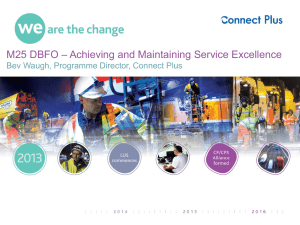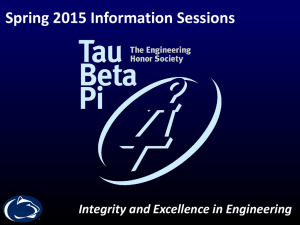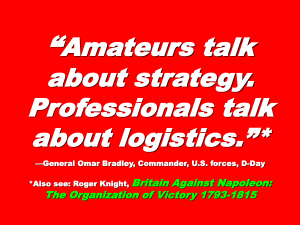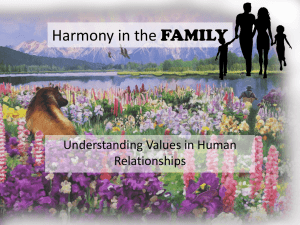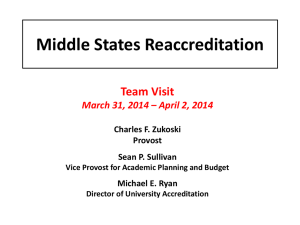IIA.FINAL.0716.13
advertisement
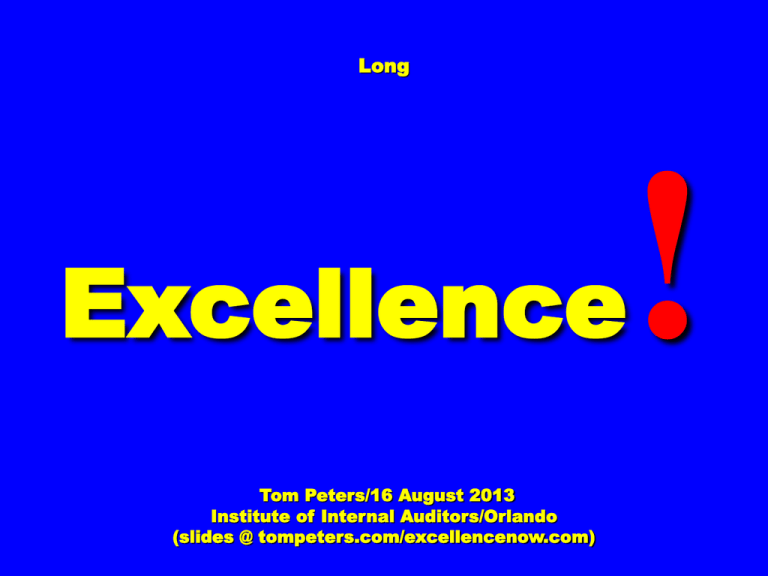
Long Excellence Tom Peters/16 August 2013 Institute of Internal Auditors/Orlando (slides @ tompeters.com/excellencenow.com) Context “At a party given by a billionaire on Shelter Island, Kurt Vonnegut informs his pal, Joseph Heller, that their host, a hedge fund manager, had made more money in a single day than Heller had earned from his wildly popular novel Catch-22 over its whole history. Heller responds … ‘Yes, but I have something he will never have … Enough. Source: John Bogle, Enough. The Measures of Money, Business, and Life (Bogle is founder of the Vanguard Mutual Fund Group) “Too Much Cost, Not Enough Value” “Too Much Speculation, Not Enough Investment” “Too Much Complexity, Not Enough Simplicity” “Too Much Counting, Not Enough Trust” “Too Much Business Conduct, Not Enough Professional Conduct” “Too Much Salesmanship, Not Enough Stewardship” “Too Much Focus on Things, Not Enough Focus on Commitment” “Too Many Twenty-first Century Values, Not Enough Eighteenth-Century Values” “Too Much ‘Success,’ Not Enough Character” Source: Chapter titles from Jack Bogle, Enough. “The notion that corporate law requires directors, executives, and employees to maximize shareholder wealth simply isn’t true. There is no solid legal support for the claim that directors and executives in U.S. public corporations have an enforceable legal duty to maximize shareholder wealth. The idea is fable.” —Lynn Stout, professor of corporate The Shareholder Value Myth: How Putting Shareholders First Harms Investors, Corporations, and the Public and business law, Cornell Law school, “Courts uniformly refuse to impose sanctions on directors or executives for failing to pursue one purpose over another. In particular, courts refuse to hold directors of public corporations legally accountable for failing to maximize shareholder wealth.” —Lynn Stout, professor of corporate and business law, Cornell Law school, in The Shareholder Value Myth: How Putting Shareholders First Harms Investors, Corporations, and the Public “On the face of it, shareholder value is the dumbest idea in the world. Shareholder value is a result, not a strategy. … Your main constituencies are your employees, your customers and your products.” —Jack Welch, FT, 0313.09, page 1 “Managers have lost dignity over the past decade in the face of wide spread institutional breakdown of trust and self-policing in To regain society’s trust, we believe that business leaders must embrace a way of looking at their role that goes beyond their responsibility to the shareholders to include a civic and personal commitment to their duty as institutional custodians. In other business. words, it is time that management became a profession.” —Rakesh Khurana & Nitin Nohria, “It’s Time To Make Management a True Profession,” HBR/10.08 Yikes! Corporate conscience/Keeper of the culture Cops Risk evaluators (strategic epicenter of the firm) Privacy assessors/guardians Global puzzle solvers in the Age of Infinite Entanglements PR managers Systems cops (overall) Forensic accountants Masters of technology Advisors/consigliore to top management Advisors/consultants to down-the-line units Really First Things Before First Things “The doctor interrupts after …* *Source: Jerome Groopman, How Doctors Think 18 … 18 … seconds! Listen = “Profession” = Study = Practice = Evaluation = Enterprise Value “Let Silence Do the Heavy Lifting” —chapter title from Susan Scott, Fierce Conversations: Achieving Success at Work and in Life, One Conversation at a Time “Everyone has a story to tell, if only you have the patience to wait for it and not get in the way of it.” —Charles McCarry, Christopher’s Ghosts Suggested addition to your statement of Core “We are Effective Listeners—we treat Listening EXCELLENCE as the Centerpiece of our Commitment to Respect and Engagement and Community and Growth.” Values: “It’s amazing how this seemingly small thing— simply paying fierce attention to another, really asking, really listening, even during a brief conversation—can evoke such a wholehearted response.” Fierce Conversations: —Susan Scott, Achieving Success at Work and in Life, One Conversation at a Time Really First Things Before First Things XFX = #1* *Cross-Functional eXcellence % XF lunches* Measure! Monthly! Part of * evaluation! [The PAs Club.] George Crile (Charlie Wilson’s War) on Gust “He had become something of a legend with these people who manned the underbelly of the Agency [CIA].” Avrakotos’ strategy: Suck Down for Success! “Success doesn’t depend on the number of people you know; it depends on the number of people you know in high places!” or “Success doesn’t depend on the number of people you know; it depends on the number of people you know in low places!” “I got to know his secretaries.” —Dick Parsons (as CEO Time Warner, on successfully dealing with Carl Icahn) Really First Things Before First Things If the regimental commander lost most of his 2nd lieutenants and 1st lieutenants and captains If he lost his sergeants it would be a catastrophe. The Army and the and majors, it would be a tragedy. Navy are fully aware that success on the battlefield is dependent to an extraordinary degree on its Sergeants and Chief Petty Officers. Does industry have the same awareness? Really First Things Before First Things In the Army, 3-star generals worry about training. In most businesses, it's a “ho hum” mid-level staff function. I would hazard a guess that most CEOs see IT investments as a “strategic necessity,” but see training expenses as “a necessary evil.” Really First Things Before First Things #1: Every meeting that does not stir the imagination and curiosity of attendees and increase bonding and cooperation and engagement and sense of worth and motivate rapid action and enhance enthusiasm is a permanently lost opportunity. Meetings Really First Things Before First Things Hard is Soft. Soft is Hard. Hard Soft [numbers, plans] [people/relationships] is Soft. is Hard. “If I could have chosen not to tackle the IBM culture head-on, I probably wouldn’t have. My bias coming in was toward strategy, analysis and measurement. In comparison, changing the attitude and behaviors of hundreds of thousands of people is very, very hard. Yet I came to see in my time at IBM that culture isn’t just one aspect of the game … it is the game.” Source: Lou Gerstner, Who Says Elephants Can’t Dance Systems Have Their Place: SECOND Place Case #1/United States Air Force Tactical Air Command/ GEN Bill Creech/“Drive bys” Case #2/Milliken & Company/CEO Roger Milliken/the 45minute grilling Case #3/Johns Hopkins/Dr. Peter Pronovost/The (real) roots of checklist power Case #4/Commerce Bank/CEO Vernon Hill/The RED button commitment Case #5/Veterans Administration/Abrogating the “culture of hiding” Case #6/Mayo Clinic/Dr. William Mayo/Teamwork makes me “100 times better” Case #7/IBM/CEO Lou Gerstner flummoxed by ingrained beliefs Case #8/Germany’s Mittelstand/excellence-in-the-genes Case #9/Department of Defense/DASD Bob Stone/tracking down the extant ”Model Installation” superstars Case #10/Matthew Kelly/Housekeepers’ dreams Case #11/Toyota/Growth or bust Excellence Tom Peters/16 August 2013 Institute of Internal Auditors/Orlando (slides @ tompeters.com/excellencenow.com) “Why in the World did you go to Siberia?” An emotional, vital, innovative, joyful, creative, entrepreneurial endeavor that elicits maximum Enterprise* (*at its best): concerted human potential in the wholehearted pursuit of EXCELLENCE in service of others.** **Employees, Customers, Suppliers, Communities, Owners, Temporary partners Excellence1982: The Bedrock “Eight Basics” 1. 2. 3. 4. 5. 6. 7. 8. A Bias for Action Close to the Customer Autonomy and Entrepreneurship Productivity Through People Hands On, Value-Driven Stick to the Knitting Simple Form, Lean Staff Simultaneous Loose-Tight Properties 1/4,096: excellencenow.com “Business has to give people enriching, or it's simply not worth doing.” rewarding lives … —Richard Branson Oath of Office: Managers/Servant Leaders Our goal is to serve our customers brilliantly and profitably over the long haul. Serving our customers brilliantly and profitably over the long haul is a product of brilliantly serving, over the long haul, the people who serve the customer. Hence, our job as leaders—the alpha and the omega and everything in between—is abetting the sustained growth and success and engagement and enthusiasm and commitment to Excellence of those, one at a time, who directly or indirectly serve the ultimate customer. We—leaders of every stripe—are in the “Human Growth and Development and Success and Aspiration to Excellence business.” “We” [leaders] only grow when “they” [each and every one of our colleagues] are growing. “We” [leaders] only succeed when “they” [each and every one of our colleagues] are succeeding. “We” [leaders] only energetically march toward Excellence when “they” [each and every one of our colleagues] are energetically marching toward Excellence. Period. A 15-Point Human Capital Development Manifesto 1. “Corporate social responsibility” starts at home—i.e., inside the enterprise! MAXIMIZING GDD/Gross Domestic Development of the workforce is the primary source of mid-term and beyond growth and profitability—and maximizes national productivity and wealth. (Re profitability: If you want to serve the customer with uniform Excellence, then you must FIRST effectively and faithfully serve those who serve the customer— i.e. our employees, via maximizing tools and professional development.) The Memories That Matter The people you developed who went on to stellar accomplishments inside or outside the company. The (no more than) two or three people you developed who went on to create stellar institutions of their own. The long shots (people with “a certain something”) you bet on who surprised themselves—and your peers. The people of all stripes who 2/5/10/20 years later say “You made a difference in my life,” “Your belief in me changed everything.” The sort of/character of people you hired in general. (And the bad apples you chucked out despite some stellar traits.) A handful of projects (a half dozen at most) you doggedly pursued that still make you smile and which fundamentally changed the way things are done inside or outside the company/industry. The supercharged camaraderie of a handful of Great Teams aiming to “change the world.” “The root of our problem is not that we’re in a Great Recession or a Great Stagnation, but rather that we are in the early Great Restructuring. Our throes of a technologies are racing ahead, but our skills and organizations are lagging behind.” Source: Race AGAINST the Machine, Erik Brynjolfsson and Andrew McAfee +400,000*/-2,000,000** “new computing technologies that destroy middle-class [whitecollar] jobs even as they create jobs for highly skilled workers who can exploit them” *Manufacturing jobs added USA 2007-2012 **White-collar jobs lost USA 2007-2012 Source: Financial Times, page 1, 0402.13 (“Clerical Staff Bears Brunt of US Jobs Crisis”) Automate This: How Algorithms Came to Rule Our World —Christopher Steiner Big Data: A Revolution That Will Transform How We Live, Work, and Think —Viktor Mayer-Schonberger and Kenneth Cukier Predictive Analytics: The Power to Predict Who Will Click, Buy, Lie, or Die —Eric Siegel Race AGAINST The Machine: How the Digital Revolution Is Accelerating Innovation, Driving Productivity, and Irreversibly Transforming Employment and the Economy —Erik Brynjolfsson and Andrew McAfee “Algorithms have already written symphonies as moving as those composed by Beethoven, picked through legalese with the deftness of a senior law partner, diagnosed patients with more accuracy than a doctor, written news articles with the smooth hand of a seasoned reporter, and driven vehicles on urban highways with far better control than a human driver.” Automate This: How Algorithms Came to Rule Our World —Christopher Steiner, Legal industry/Pattern Recognition/Discovery (ediscovery algorithms): 500 lawyers to … ONE Source: Race AGAINST the Machine, Erik Brynjolfsson and Andrew McAfee MetaMed “[Michael Vassar/ founder] is creating a better information system and new class of people to ‘Almost all healthcare people get is going to be done—hopefully—by algorithms within a decade or two. We used to rely on doctors to be experts, and we’ve manage it. crowded them into being something like factory workers, where their job is to see one patient every 8 to 11 minutes and implement a by-the-book solution. I’m talking about creating a new expert profession’—medical quants, almost like hedgefund managers, who could do the high-level analytical work of directing all the information that flows into the world’s hard drives. Doctors would now be aided by Vassar’s new information experts who would be aided by advanced artificial intelligence.”—New York /0624.13 “ … The audience then voted on the identity of each composition.* [Music theory professor and contest organizer] Larson’s pride took a ding when his piece was fingered as that belonging to the computer. When the crowd decided that [algorithm] Emmy’s piece was the true product of the late musician [Bach], Larson winced.” —Christopher Steiner, Automate This: How Algorithms Came to Rule Our World *There were three: Bach/Larson/Emmy-the-algorithm. “Human level capability has not turned out to be a special stopping point from an engineering perspective. ….” Source: Illah Reza Nourbakhsh, Professor of Robotics, Carnegie Mellon, Robot Futures “Aviva, a large insurance firm, has studied the idea of using credit reports and consumermarketing data as proxies for the analysis of blood and urine samples for certain applicants. The intent is to identify those who may be at higher risk of illnesses like high blood pressure, diabetes, or depression. The method uses lifestyle data that includes hundreds of variables such as hobbies, the websites people visit, and the amount of television they watch, as well as estimates of their income. Aviva’s predictive model, developed by Deloitte Consulting, was considered successful at identifying health risks.” Source: Big Data: A Revolution That Will Transform How We Live, Work, and Think, by Viktor Mayer-Schonberger and Kenneth Cukier “Flash forward to dystopia. You work in a chic cubicle, sucking chicken-flavor sustenance from a tube. You’re furiously maneuvering with a joystick … Your boss stops by and gives you a look. ‘We need to talk about your loyalty to this The organization you work for has deduced that you are considering quitting. It predicts your plans and intentions, possibly before you have even conceived them.” —Eric Siegel, Predictive company.’ Analytics: The Power to Predict Who Will Click, Buy, Lie, or Die (based on a real case, an HP “Flight risk” PA model developed by HR, with astronomical savings potential) Lesson47: WTTMSW WHOEVER TRIES THE MOST STUFF WINS In Search of Excellence /1982: The Bedrock “Eight Basics” 1. 2. 3. 4. 5. 6. 7. 8. A Bias for Action Close to the Customer Autonomy and Entrepreneurship Productivity Through People Hands On, Value-Driven Stick to the Knitting Simple Form, Lean Staff Simultaneous Loose-Tight Properties “We made mistakes, of course. Most of them were omissions we didn’t think of when we initially wrote the software. We fixed them by doing it over and over, again and again. We do the same today. While our competitors are still sucking their thumbs trying to make the design perfect, we’re already on prototype version #5. By the time our rivals are ready with wires and screws, we are on version #10. It gets back to planning versus acting: We act from day one; others plan how to plan—for months.” —Bloomberg by Bloomberg LITTLE = Big carts = Source: Wal*Mart “When Friedman slightly curved the right angle of an entrance corridor to one property, he was ‘amazed at the magnitude of change in pedestrian behavior’ (the percentage who entered increased from one-third to nearly two-thirds.” —Natasha Dow Schull, Addiction By Design: Machine Gambling in Las Vegas Glaring Eyes: -62% Source: PLOS ONE (via The Atlantic CITIES /0429.13) “You will become like the five people you associate with the most—this can be either a blessing or a curse.” —Billy Cox WE ARE WHAT WE EAT/WE ARE THE COMPANY WE KEEP The “Hang Out Axiom”: The “We are what we eat”/ “We are who we hang out with” Axiom: At its core, every (!!!) relationship-partnership decision (employee, vendor, customer, etc., etc.) is a strategic decision about: “Innovate, ‘Yes’ or ‘No’ ” “The prospect of contracting a gofer on an a la carte basis is enticing. For instance, wouldn’t it be convenient if I could outsource someone to write a paragraph here, explaining the history of outsourcing in America? Good idea! I went ahead and commissioned just such a paragraph from Get Friday, a ‘virtual personal assistant- firm based in Bangalore. … The paragraph arrived in my in-box ten days after I ordered it. It was 1,356 words. There is a bibliography with eleven sources. … At $14 an hour for seven hours of work, the cost came to $98. …” —Patricia Marx, “Outsource Yourself,” The New Yorker, 01.14.2013 (Marx describes in detail contracting out everything associated with hosting her book club —including the provision of “witty” comments on Proust, since she hadn’t had time to read the book—excellent comments only set her back $5; the writer/contractor turned out to be a 14-year-old girl from New Jersey.) “Who’s the most interesting person you’ve met in the last 90 days? How do I get in touch with them?” —Fred Smith 14,000 20,000 14,000/eBay 20,000/Amazon 30/Craigslist Dov Frohman: Dov Frohman: The “50% Rule” “Daydream!” Source: Dov Frohman (& Robert Howard), Leadership The Hard Way: Why Leadership Can’t Be Taught —And How You Can Learn It Anyway (Chapter 5, “The Soft Skills Of Hard Leadership”)
